#cypriniformes
Explore tagged Tumblr posts
Text

Redline Torpedo Barb (Dawkinsia denisonii), Cyprinidae, order Cypriniformes, foun in the Western Ghats of India
ENDANGERED.
photograph by Meenkaran
296 notes
·
View notes
Text
Taxonomy Tournament: Fish
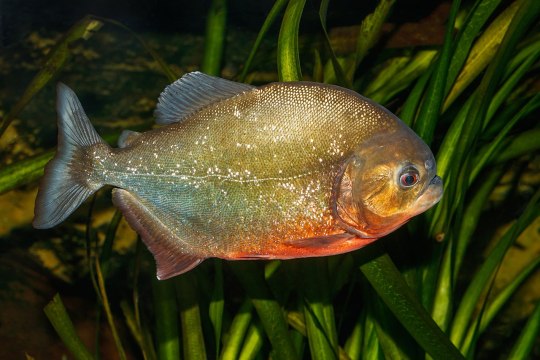

Characiformes. This order is made up of often carnivorous fish, such as the piranha, x-ray tetra and lutefish
Cypriniformes. This order is made up of carps and their relatives, such as minnows and loaches.
#animals#biology#polls#poll tournament#zoology#piranhas#xray fish#fish#carps#Characiformes#Cypriniformes#0x1bv0xe4#Animal Tournament#Animal Tournament Round 1
317 notes
·
View notes
Text
Uncharismatic Fact of the Day
Not all buffalo live on the plains; some have made their home right in central North America's rivers! The bigmouth buffalo fish is the largest North American member of the Catostomidae or "sucker" family, reaching up to 1.2 m (4 ft) and 36 kg (80 lbs)! They are also the longest-lived freshwater fish, with many individuals easily reaching 100 years in age.

(Image: A pair of bigmouth buffalo fish (Ictiobus cyprinellus) by Joel Sartore)
Want to request some art or uncharismatic facts? Just send me proof of donation of any amount to any of the fundraisers on this list, or a Palestinian organization of your choice! Proof does not have to include any personal info– only the date, the amount, and the recipient. Even one dollar can go a long way!
#bigmouth buffalo#Cypriniformes#Catostomidae#buffalofish#suckers#cyprinid fish#ray-finned fish#bony fish#fish#uncharismatic facts
113 notes
·
View notes
Text

Common carp, perch, and mirror carp By: G. I. Bernard From: Natural History Magazine 1984
153 notes
·
View notes
Text


of all the nonsensical pokemon evolutions i feel this one isn't really talked about. like i think we're missing a few steps here
#i can see bits of how they're related (mouth and dorsal fin) but those are two entirely different animals#like how do we get a catfish from a loach#their orders (cypriniformes and siluriformes) are closely related i guess??#at least with remoraid to octillery in beta designs the weapon motif was a lot clearer ??
20 notes
·
View notes
Text
A serene view of koi swimming by….
#videos#Phylum: Chordata#Class: Actinopterygii#Order: Cypriniformes#Family: Cyprinidae#Genus: Cyprinus#Cyprinus carpio#koi fish#Cyprinus carpio koi#koi#fish
1 note
·
View note
Note
also meat cup anon again please tell me abt cichlid fish they sound neat!
Cichlids!!! we got
bonus jaw

[source]
baby storage in mouth
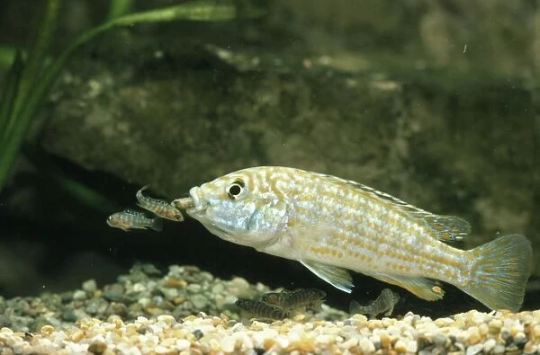
the range

[source]
but I'll be honest the weird jaws I was thinking about when I said cichlid were actually cypriniform protruding jaws and I just got my fish names fucked up. Check this shit out too though

[source]

[source]
I haven't read any of the papers I got these figures from as a disclaimer. I just like images
86 notes
·
View notes
Link
1 note
·
View note
Text
don't fucking challenge me i know every beast
NON-BEASTLY BEASTS:
Non-ParaHoxozoa:
Calcarea (Calcareous Sponges)
Hexacinellida (Glass Sponges)
Demospongiae (Demosponges)
Tentaculata (Tentacled Ctenophores)
Beroida (Non-Tentacled Ctenophores)
ParaHoxozoa, Non-Nephrozoa:
Placozoa
Anthozoa (Corals, Sea Pens, and Tube-Dwelling Anenomes)
Medusozoa (Jellyfish and Hydrozoans)
Myxozoa
Xenacoelomorpha
MINIBEASTS:
Spiralia, Non-Lophotrochozoa:
Gnathifera (Rotifers and Jaw Worms)
Mesozoa
Rouphozoa (Flatworms and Gastrotrichs)
Lophotrochozoa, Non-Mollusca:
Cycliophora
Annelida (Segmented Worms)
Nemertea (Ribbon Worms)
Bryozoa
Entoprocta
Phorodina (Horseshoe Worms)
Brachiopoda
Mollusca:
Solenogastres
Caudofoveata
Polyplacophora (Chitons)
Bivalvia (Clams, Scallops, Mussels, Oysters, Cockles, and others)
Monoplacophora
Scaphopoda (Tusk Shells)
Gastropoda (Snails, Slugs, Sea Snails, Sea Slugs, and others)
Cephalopoda (Nautiloids, Cuttlefish, Squid, and Octopi)
Ecdysozoa, Non-Arthropoda:
Loricifera
Priapulida (Penis Worms [sic])
Kinorhyncha (Mud Dragons)
Nematoda (Roundworms)
Nematomorpha (Horsehair Worms)
Tardigrada (Tardigrades)
Onchyophora (Velvet Worms)
Arthropoda, Non-Mandibulata:
Pycnogonida (Sea Spiders)
Xiphosura (Horseshoe Crabs)
Acariformes (Cheese Mites, Scabies Mites, Eyelash Mites, House Mites, and others)
Opiliones (Harvestmen)
Ricinulei (Hooded Tickspiders)
Solifugae (Camel Spiders)
Parisitiformes (Ticks, Varroa Mites, and others)
Pseudoscorpiones (Pseudoscorpions)
Scorpiones (Scorpions)
Araneae (Spiders)
Amblypigi (Whip Spiders)
Urgopygi (Whip Scorpions)
Mandibulata, Non-Insecta:
Chilopoda (Centipedes)
Symphyla (Pseudocentipedes)
Pauropoda
Diplopoda (Millipedes)
Ostracoda (Seed Shrimp)
Mystacocarida
Branchiura (Fish Lice)
Pentastomida (Tongue Worms)
Copepoda (Copepods)
Tantulocarida
Thecostraca (Barnacles and others)
Malacostraca (Crabs, Lobsters, Shrimp, Isopods, Amphipods, and others)
Cephalocarida (Horseshoe Shrimp)
Branchiopoda (Fairy Shrimp, Tadpole Shrimp, Water Fleas, and others)
Remipedia
Collembola (Springtails)
Protura
Diplura (Two-Pronged Bristletails)
Insecta, Non-Neoptera:
Archaeognatha (Jumping Bristletails)
Zygentoma (Silverfish, Firebrats, and others)
Odonatoptera (Dragonflies and Damselflies)
Ephemeroptera (Mayflies)
Neoptera, Non-Holometabola:
Zoraptera (Angel Insects)
Dermaptera (Earwigs)
Plecoptera (Stoneflies)
Orthoptera (Grasshoppers, Crickets, and others)
Mantodea (Mantises)
Blattodea (Cockroaches and Termites)
Notoptera (Ice Crawlers and Rock Crawlers)
Phasmatodea (Stick Insects and Leaf Insects)
Embioptera (Webspinners)
Psocodea (Lice)
Hemiptera (Shield Bugs, Aphids, Scale Insects, Cicadas, Planthoppers, Assassin Bugs, Water Boatmen, Pond Skaters, and others)
Thysanoptera (Thrips)
Holometabola
Hymenoptera (Sawflies, Bees, Wasps, and Ants)
Strepsiptera
Coleoptera (Beetles)
Raphidioptera (Snakeflies)
Neuroptera (Lacewings, Antlions, and others)
Megaloptera (Dobsonflies and others)
Lepidoptera (Butterflies and Moths)
Trichoptera (Caddisflies)
Diptera (Flies, Mosquitoes, Gnats, Midges, Hoverflies, and others)
Mecopteroidea (Scorpionflies, Hangingflies, and Fleas)
SLIGHTLY MORE BEASTLY BEASTS:
Ambulacraria:
Echinodermata (Starfish, Sea Urchins, Brittle Stars, Feather Stars, and others)
Hemichordata (Acorn Worms and others)
Chordata (Non-Vertebrata):
Leptocardii (Lancelets)
Tunicata (Sea Squirts, Salps, Pyrosomes, and others)
Vertebrata (Non-Eutelostomi):
Myxini (Hagfish)
Hyperoartia (Lampreys)
Elasmobranchii (Sharks, Rays, and Skates)
Holocephali (Chimaeras)
Actinopterygii (Non-Acanthomorpha):
Cladistia (Bichirs and Reedfish)
Acnipenseriformes (Paddlefish and Sturgeons)
Halecomorphi (Bowfins)
Ginglymodi (Gars)
Elopocephalai (Eels, Ladyfish, Halosaurs, and others)
Osteoglossocephala (Arapaima, Goldeye, and others)
Clupei (Herrings and Anchovies)
Apelocephali (Slickheads and others)
Anotophysa (Milkfish, Beaked Salmon, and others)
Cypriniformes (Carp, Goldfish, Loaches, Minnows, and others)
Characiformes (Characins, Pacu, Pirahnas, Tetras, and others)
Gymnotiformes (Knifefish and Electric Eels)
Siluriformes (Catfish)
Lepidogalaxii (Salamanderfish)
Protacanthopterygii (Salmon, Pike, Trout, Barreleye, and others)
Stomiati (Smelts, Marine Hatchetfish, and others)
Ateleopodia (Jellynose Fish)
Aulopa (Bombay Duck and Lancetfish)
Myctophata (Lanternfish)
Acanthomorpha:
Lampridacea (Oarfish, Opah and others)
Paracanthomorphacea (Cods, Dories, Cavefish, and others)
Polymixiacea (Beardfish)
Berycimorphaceae (Fangtooths, Pineconefishes, and others)
Holocentrimorphaceae (Soldierfish)
Ophidiiformes (Pearlfish)
Batrachoidimophara (Toadfish)
Gobiomorpharia (Seahorses, Pipefish, Tunas, Flying Gurnards, and others)
Anabantaria (Gouramis, Swamp Eels, and others)
Carangaria (Swordfish, Flatfish, Remoras, and others)
Ovalentaria (Blennies, Cichlids, Flying Fish, Mullets, and others)
Eupercaria (Anglerfish, Pufferfish, Wrasses, Sunfish, Sticklebacks, Lumpsuckers, Lionfish, Angelfish, Perches, Archerfish, Triggerfish, Bass, and others)
Sarcopterygii:
Actinistia (Coelocanths)
Dipnoi (Lungfish)
BEASTS PROPER:
Lissamphibia
Salientia (Frogs and Toads)
Caudata (Salamanders and Newts)
Gymnophiona (Caecilians)
Reptilia (Non-Aves)
Rhynchocephalia (Tuatara)
Dibamidae (Blind Skinks)
Gekkota (Geckos and Flap-Footed Lizards)
Scinciformata (Skinks and others)
Laterata (Tegus and Worm Lizards)
Anguimorpha (Slow Worms, Monitors, Gila Monster, and others)
Iguania (Anoles, Iguanas, Chameleons, and others)
Serpentes (Snakes)
Testudines (Turtles and Tortoises)
Crocodilia (Crocodiles, Gharials, Alligators, and Caiman)
Aves (Non-Passeriformes):
Palaeognathae (Ostriches, Kiwis, and others)
Galloanserae (Chickens, Ducks, and others)
Mirandornithes (Flamingos and Grebes)
Columbimorphae (Doves and others)
Otidimorphae (Cuckoos, Turacos, and Bustards)
Gruimorphae (Gulls, Cranes, Auks, and others)
Ophistocomidae (Hoatzins)
Strisores (Hummingbirds, Nightjars, Potoos, and others)
Phaethoquornithes (Boobies, Loons, Ibises, Penguins, Albatrosses, Tropicbirds, and others)
Acciptirimorphae (Vultures, Hawks, Eagles, and others)
Strigiformes (Owls)
Coraciimorphae (Kingfishers, Woodpeckers, Quetzals, and others)
Cariamiformes (Seriemas)
Falconiformes (Falcons)
Psittaciformes (Parrots)
Passeriformes:
Acanthisitti (New Zealand Wrens)
Tyranni (Overnbirds, Spadebills, Gnateaters, and others)
Menurida (Lyrebirds and others)
Climacterida (Bowerbirds and others)
Meliphagida (Honeyeaters, Bristlebirds, and others)
Orthonychida (Logrunners and others)
Corvides (Crows, Jays, Boatbills, Shriketits, Sittellas, Birds-Of-Paradise and others)
Passerides (Satinbirds, Sparrows, Larks, Tits, Oxpeckers, Thrushes, Wrens, Finches, Tanagers, Nuthatchers, and others)
Mammalia (Non-Laurasiatheria):
Monotremata (Platypus and Echidnas)
Marsupialia (Kangaroos, Opossums, Wombats, and others)
Xenarthra (Anteaters, Sloths, and others)
Athrotheria (Elephants, Manatees, Aardvarks, and others)
Lagomorpha (Rabbits, Hares and others)
Rodentia (Mice, Rats, Cavies, Beavers, Squirrels, and others)
Scandentia (Treeshrews)
Dermoptera (Colugos)
Primates (Lemurs, Marmosets, Baboons, Gibbons, Chimpanzees, and others)
Lauasiatheria (Non-Carnivora):
Eulipotyphla (Shrews, Moles, Hedgehogs, and others)
Chiroptera (Bats)
Artiodactyla (Girrafes, Deer, Whales, Pigs, Camels, and others)
Perissodactyla (Horses, Tapir, and Rhinoceros)
Pholidota (Pangolins)
Carnivora:
Viverroidea (Hyenas, Mongooses, Civets, and others)
Feloidea (Lions, Tigers, Caracals, Wildcats, Leopards, and others)
Nandiniidae (African Palm Civet)
Caninae (Wolves, Foxes, and others)
Ursidae (Bears)
Musteloidea (Skunks, Weasels, Otters, Raccoons, and others)
Pinnipedia (Seals, Sea Lions, and Walruses)
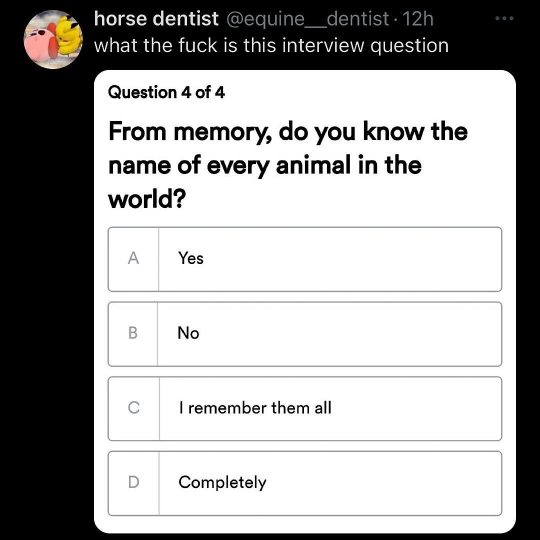
Interview questions for gym leaders
4K notes
·
View notes
Text
Cá Koi Là Cá Gì ? Nguồn Gốc, Phân Loai, Ý Nghĩa Phong Thuỷ

Trong thế giới cá cảnh, cá Koi nổi tiếng với vẻ đẹp tuyệt vời và ý nghĩa tinh thần sâu sắc mà nó mang lại. Nhưng cá Koi là cá gì? Hãy cùng khám phá sâu hơn về loài cá này trong bài viết sau nhé.
Tổng quan về cá koi
Cá koi là một thuật ngữ phổ biến để chỉ một giống cá mà chặt chẽ liên quan đến cá chép vàng. Nó cũng được biết đến dưới các tên khác như cá chép Koi (tiếng Nhật: 鯉 / こい) hoặc cá chép Nhật, theo cách gọi thông thường tại Việt Nam. Theo thông tin từ Wikipedia, giống cá này được phân loại như sau: - Giới: Animalia - Ngành: Chordata - Lớp: Actinopterygii - Bộ: Cypriniformes - Họ: Cyprinidae - Chi: Cyprinus - Loài: C. Carpio - Phân loài: C. c. Haematopterus
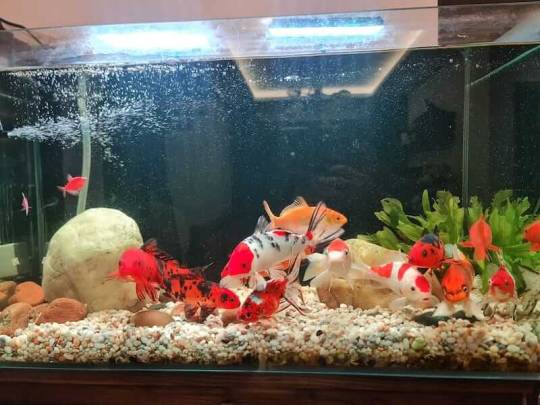
Nguồn gốc của cá koi
Dựa trên một số tài liệu nghiên cứu khoa học, có thông tin cho rằng cá koi ban đầu xuất phát từ Trung Quốc và sau đó được nhập khẩu vào Nhật Bản từ những năm đầu của thế kỉ 19. Tại Nhật Bản, chúng đã trải qua quá trình thuần hóa và lai tạo qua nhiều thế hệ để trở thành loài cá cảnh được nuôi chăm sóc. Ban đầu, chúng được gọi là cá chép Nishikigoi (tiếng Nhật: 錦鯉/ にしきこい), có nghĩa là cá chép thổ cẩm hoặc cá chép có nhiều màu sắc theo tiếng Việt. Vào năm 1914, để tôn vinh hoàng tử Hirohito của Nhật Bản, quốc gia này đã tổ chức triển lãm đầu tiên tại Tokyo và đảo Niigata để trưng bày các loại cá chép Koi. Từ đó, cá chép Nhật Bản trở nên phổ biến hơn. Tên gọi "cá Koi" được chấp nhận và lan rộng trong việc mua bán. Từ "Koi" trong tiếng Nhật có nghĩa là cá chép, nhưng cũng có thể hiểu là tình yêu, lòng trung thành. XEM NHANH VIDEO VỀ "cá koi là cá gì?Tại sao cá Koi có giá siêu đắt? Cá Koi thật sự là gì??": https://www.youtube.com/watch?v=5tHxJTADpQM
Cá Koi có mấy loại?
Hiện nay, cá Koi có rất nhiều cách phân loại khác nhau, nhưng chủ yếu có thể phân thành hai loại chính là Koi chuẩn và Koi bướm. - Koi chuẩn: Đây là giống cá Koi nguyên thuỷ về hình dáng nhưng có nhiều màu sắc đẹp mắt. Koi chuẩn là loại phổ biến nhất và thường được nuôi trong ao, hồ, tiểu cảnh để trang trí. - Koi bướm: Còn được gọi là cá chép vây dài, giống cá này bắt đầu được nhân giống từ năm 1980. Koi bướm có phần vi, vây và đuôi dài khác biệt so với giống cá nguyên thủy.Khi bơi, chúng có hình dáng uyển chuyển rất đẹp mắt, thường được nuôi làm cảnh trong hồ kiếng
Đặc điểm hình thái của cá koi
Dù thuộc vào loại giống nào, một con cá koi Nhật Bản thuần chủng thường có những đặc điểm hình thái sau: - Thân hình đẹp mắt, phong phú với nhiều màu sắc tươi sáng. - Có giá trị trang trí cao trong việc trưng bày. - Là loài cá chép có vảy, đầu hơi nhô và thân có vây ở ngực, lưng, bụng và đuôi. - Phát triển kích thước liên tục, với tốc độ gia tăng khoảng từ 50 đến 150 mm mỗi năm nếu được nuôi trong điều kiện lý tưởng. Tuy nhiên, từng loại giống cá sẽ có những đặc điểm riêng biệt về màu sắc, hình dáng, và kích thước...

Tập tính của cá koi
Tập tính ăn uống Cá koi là loài cá ăn tạp và khá thích ăn. Tuy nhiên, thức ăn dành cho cá koi cần được bảo quản vệ sinh vì chúng rất quan trọng đối với sự sức khỏe của cá. Đồng thời, không nên cho cá ăn quá nhiều và thức ăn phải có nguồn gốc rõ ràng để tránh ảnh hưởng đến hình dáng và màu sắc của cá trong tương lai. Tập tính sinh sản Cá koi thường sinh sản vào mùa xuân và mùa thu. Độ tuổi tốt nhất để cá koi cái sinh sản là từ 2 đến 3 tuổi. Thời điểm sinh sản thường là khi thời tiết mát mẻ và nhiệt độ nước hồ không quá cao, thường là vào ban đêm hoặc sáng sớm. Tập tính sinh sản thường diễn ra theo nhóm, với một con cá cái và 2-3 con cá đực bơi cùng nhau. Số lượng trứng mà cá cái có thể đẻ ra thường dao động từ 150.000 đến 200.000 trứng. Trứng cá sẽ dính vào các giá thể như lục bình, bèo hoặc các giá thể nhân tạo mà người nuôi đã chuẩn bị. Sau khi cá cái hoàn thành việc đẻ trứng, các con cá đực sẽ tiếp tục bơi vào và thụ tinh các trứng. Sau khoảng 40-50 giờ, trứng cá sẽ nở thành cá non. Trong thời gian chờ đợi trứng nở, cần đảm bảo rằng các giá thể và nước trong hồ (hoặc bể) cá được duy trì trong tình trạng sạch sẽ và nhiệt độ ổn định.

Ý nghĩa của cá koi
Ngoài vẻ đẹp bề ngoài, cá koi còn được biết đến như là "quốc ngư" của Nhật Bản với nhiều ý nghĩa sâu sắc. Loài cá này là bi��u tượng của sức mạnh và ý chí trong cuộc sống, xuất phát từ câu chuyện cổ xưa "Cá chép vượt vũ môn hóa rồng". Người xưa tin rằng, kích thước của cá càng lớn thì may mắn và thành công càng nhiều. Cá koi Nhật Bản còn được coi là biểu tượng của: - Sự giàu sang - Phú quý - Thành công - Phồn thịnh - Trường thọ - Sự can đảm - Hoàn bão Ngoài ra, với người chơi cá koi, mỗi đặc điểm màu sắc của cá mang ý nghĩa khác nhau: - Cá trắng với khoang đỏ: ý nghĩa về thành công trong sự nghiệp. - Cá trắng với khoang đen hoặc cá màu đen: ý nghĩa về sự biến động và thay đổi liên tục trong cuộc sống. - Cá thân xám bạc: biểu tượng cho thành công không ngờ và vượt trội. - Cá vàng: ý nghĩa về tài lộc, sự an khang. Trong một hồ cá koi đẹp, việc kết hợp nuôi nhiều loại cá khác nhau sẽ mang lại nhiều điều tốt lành nhất. Sự hòa quyện của các đàn cá nhiều màu sắc sẽ chắc chắn làm cho nhiều người phải trầm trồ và ngưỡng mộ. XEM NHANH VIDEO VỀ " 7 Bí Ẩn Ly Kỳ Và Thú Vị Về Cá Chép Koi Mà Đến Dân Nuôi Cá Sành Sỏi Chưa Chắc Đã Biết I Kính Lúp TV": https://www.youtube.com/watch?v=S1Cw2OttY9Y
Các giống cá koi được nhiều người lựa chọn để nuôi
Sau hàng thế kỉ của quá trình nuôi và nhân giống, người Nhật đã thành công trong việc lai tạo và phát triển nhiều loại cá koi khác nhau. Tên gọi của từng giống cá thường được đặt dựa trên các gam màu trên thân và các đặc điểm hình thể để phân biệt chúng. Mặc dù có rất nhiều giống cá koi đã được ghi nhận, tuy nhiên tại Việt Nam, người ta thường ưa chuộng một số loại cụ thể. Dưới đây là danh sách 18 giống cá koi đẹp được nhiều người ưa chuộng nhất: Cá Koi Kohaku Kohaku là một giống cá koi dễ nhận biết nhất nhờ vào đặc điểm của chúng là thân mình màu trắng kết hợp với những khoang màu đỏ. Khoang màu đỏ thường chiếm từ 50 đến 70% diện tích bề mặt da cá. Người chơi cá cảnh thường đánh giá rằng, khi khoang đỏ trên thân cá càng lớn và màu sắc càng sáng đẹp, thì giá trị của cá càng cao và được ưa chuộng. Một số đặc điểm cơ bản của giống cá Kohaku: - Mức độ chăm sóc: Dễ nuôi, có sức khỏe tốt. - Tính cách: Hiền lành - Kích thước của cá trưởng thành: Trung bình khoảng 1m (tối đa 1.5m). - Tuổi thọ: Dao động từ 20 đến 40 năm.

Cá Koi Taisho Sanke Cá Taisho Sanke, hay còn gọi là Sanke, là một giống cá được lai tạo và phát triển từ giống cá Kohaku. Do đó, đặc điểm chính trên cơ thể của chúng vẫn là màu trắng với những khoang màu đỏ, nhưng được pha trộn thêm một chút màu đen. Giá trị của cá Koi Sanke thường được đánh giá dựa trên độ sáng và sạch của phần trắng trên thân cá, được gọi là shiroji. Đặc điểm cơ bản của Sanke gần giống với Kohaku, nhưng kích thước tối đa của chúng chỉ đạt khoảng 90cm. Trong hàng ngàn con cá cùng giống, rất hiếm khi bạn có thể tìm thấy hai con Sanke có hoa văn giống nhau. Vẻ đẹp của mỗi con cá là duy nhất, làm cho việc sở hữu chúng trở nên đặc biệt và phong phú.

Cá Koi Showa Sanshoku Showa Shanshoku, cùng với Tancho Sanke và Kohaku, là ba phân loại phổ biến nhất của cá Koi Nhật Bản, được gọi chung là Gosanke. Cá Koi Showa Shanshoku thường được gọi tắt là Showa. Jukichi Hoshino lai tạo giống cá này từ giống cá gốc là Kohaku vào những năm 1927.Showa Shanshoku chia sẻ nhiều đặc điểm giống với dòng cá Tancho Sanke, nhưng cũng có một số khác biệt nhỏ.
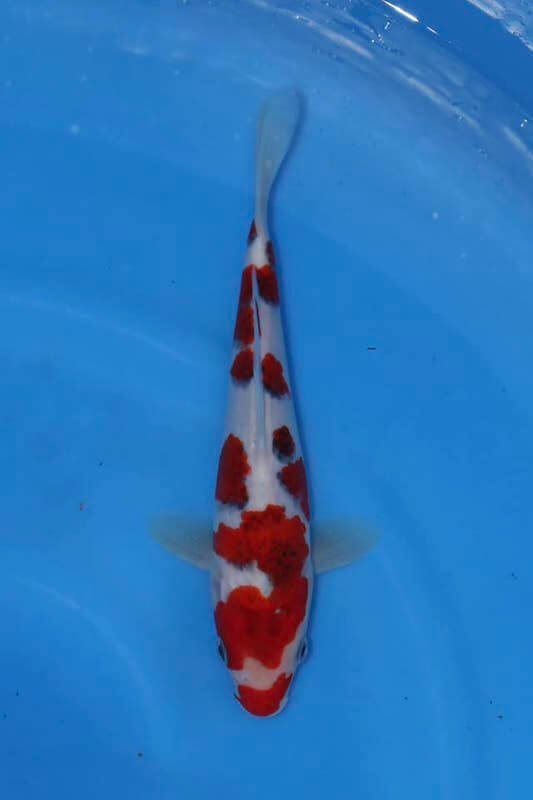
Phân biệt Showa và Sanke Hai loại cá này đều có ba màu sắc đặc trưng là trắng, đỏ và đen, điều này khiến nhiều người dễ bị nhầm lẫn, đặc biệt là những người mới chơi cá Koi. Tuy nhiên, nếu quan sát kỹ, chúng ta có thể dựa vào các đặc điểm riêng để phân biệt chúng: - Cá koi Sanke: Thân cá có màu trắng sáng, các khoang đỏ rộng và phần đốm đen ít. Thường thì, đỉnh đầu của cá không có bất kỳ đốm đen nào.Các vệt đen trên thân cá Sanke thường đậm, sắc nét và tách biệt rõ ràng với các vệt màu trắng và đỏ. - Cá koi Showa: Các khoang đen (Sumi) chiếm tỷ lệ lớn trên thân cá và có thể lan lên cả phần đỉnh đầu. Màu đen ở giống cá Showa thường đục hơn một chút. Chi tiết vây ngực của chúng có thể có các bông màu đen (gọi là Motoguro). Cá Koi Shiro Utsuri Đây là một giống cá thuần chủng có lịch sử lâu đời nhất, với đặc điểm thân hình chỉ có hai màu trắng và đen. Có hai loại cơ bản của giống cá Koi Shiro Utsuri: - Ginrin Shiro Utsuri: Tất cả các vảy cá đều có bề mặt bóng kim loại bạc, với các mảng màu đen và trắng xen kẽ một cách cân đối. - Shiro Utsuri Doitsu: Thân cá mịn màng, không có vảy. Các cá Koi Shiro Utsuri thường có những vệt Sumi (đốm đen) xuất hiện thậm chí cả trên đỉnh đầu. Gốc vây lưng của chúng thường có Motoguro (bông đen). Motoguro này của Shiro Utsuri là các vệt màu đen lớn phát triển từ dưới đường bên của cá. Điều này cũng là điểm khác biệt giữa Shiro Utsuri và giống cá Shiro Bekko.

Cá Koi Asagi Đây cũng là một loài cá có lịch sử lâu đời, là một trong những giống cá xuất hiện đầu tiên ở Nhật Bản. Koi Asagi được xem là tổ tiên của một số nhóm cá koi sau này. Chúng có hình dáng và màu sắc đặc biệt. Lớp vảy của chúng tạo thành hình quả trám hoặc kết mạng khá rõ nét (gọi là Fukurin). Asagi thường được chia thành 4 loại dựa vào đặc điểm của lớp vảy trên lưng, bao gồm: Konjo Asagi, Narumi Asagi, Mizo Asagi và Ginrin Asagi. Ở Việt Nam, giống cá này còn được gọi với tên là “cá chép Ngũ Phúc”, mang ý nghĩa của sự ổn định, sự điều hòa và sự lưu thông của vận khí. Ngoài ra, nó cũng mang ý nghĩa về mong muốn cho gia đình mình sự bình an và hạnh phúc. Cá Koi Bekko Là một dòng cá có thân mình thường chỉ có hai màu sắc: trắng – đen (Shiro Bekko), đỏ – đen (Aka Bekko) hoặc vàng – đen (Ki Bekko). Koi Bekko được nhận biết dễ dàng bởi mắt to và thân hình tròn. Dòng Koi này có hình dáng tương tự như dòng Utsuri. Qua việc quan sát cẩn thận, ta có thể nhận thấy phần mũi và râu ở hai bên miệng cá. Vảy của chúng thường mờ và không có sự phản chiếu ánh kim. Phần vai và bụng có khuynh hướng bầu và tròn hơn so với cá Koi thông thường.

Cá Koi Chagoi Giống Koi này được nuôi khá phổ biến và thường được coi là thủ lĩnh trong đàn cá. Trong hồ cá, Koi Chagoi có khả năng bơi nhanh, đuôi mạnh mẽ và sức sống rất tốt. Đuôi cá và vây lưng thường mập và dày. Thân cá có màu sắc đồng nhất với vây. Vùng đầu và vai cá thường có hình dạng mập mạp. Chagoi là loại cá đơn sắc, không có sự phản chiếu ánh kim loại. Khi còn nhỏ, chúng có thể giống những con cá khác. Tuy nhiên, với bản tính ưa ăn, chúng có khả năng tăng kích thước và cân nặng nhanh chóng trong thời gian ngắn. Màu sắc thường là cách để phân biệt loại cá Koi này: Chagoi màu nâu, Soragoi (xanh dương xám) hoặc Midorigoi (xanh lá cây nhạt). Hoặc có thể phân biệt theo dòng khác như Doitsu Chagoi (da trơn, không có vảy) và Ginrin Chagoi (vảy óng ánh bạc). Cá Koi Tancho Vẻ đẹp của Koi Tancho thu hút nhiều người mua bởi sự thanh lịch và sang trọng của chúng. Giống cá này có điểm đặc biệt là chấm đỏ nằm ở trung tâm phần đầu của cá, làm cho chúng dễ dàng phân biệt với các giống Koi khác. Đặc điểm này thường gợi nhớ đến quốc kỳ của Nhật Bản. Về hình dáng, chúng vẫn giữ nguyên vẻ ngoài của một chú cá Koi tiêu chuẩn. Một chú cá Koi Tancho thuần chủng chỉ có thân mình trắng muốt và một chấm đỏ duy nhất (Tancho Kohaku) là rất hiếm. Tuy nhiên, chúng phổ biến hơn trong hai dòng khác là Tancho Sanke và Tancho Showa. Giá của loại cá Koi thuần chủng này khá cao do tính hiếm có của chúng trong quá trình lai tạo. Chấm đỏ ở phần đầu của cá Koi Tancho càng hoàn hảo thì chúng thường được mang ra đấu giá và thu hút sự săn đón từ các đại gia, điều này thường được xem là biểu tượng của đẳng cấp và giàu có. Theo quan điểm phong thủy, chúng cũng mang ý nghĩa về vun đắp, thúc đẩy sự thăng tiến trong sự nghiệp và củng cố địa vị cũng như quyền lực.

Cá Koi Goshiki Đây là một dòng cá được tạo ra bằng cách kết hợp hai giống Koi là Kohaku và Asagi. Cá Koi Goshiki dễ nhận biết bởi vảy trắng kèm theo dải màu đỏ đặc trưng trên nền đen. Nếu loại bỏ phần chấm đen (Ai) trên nền trắng (Shiroji), chúng sẽ trở thành Kohaku. Khi còn nhỏ, màu sắc của chúng thường không rõ ràng. Tuy nhiên, khi chúng lớn lên và được nuôi dưỡng, màu sắc của chúng sẽ trở nên sáng đẹp và ấn tượng hơn, làm cho chúng trở nên phổ biến và được nhiều người yêu thích. Có ba dòng chính của Koi Goshiki: - Dòng 1: Mang nhiều đặc điểm của cá Koi Asagi hơn, với các dải màu đen phủ trên toàn bộ thân (bao gồm cả vùng Hi và Shiroji). - Dòng 2: Mang nhiều đặc điểm của cá Koi Kohaku, với khoang đỏ (Hi) rõ ràng và đậm, chấm đen chỉ xuất hiện trên vùng Shiroji. - Dòng 3: Mang nhiều đặc điểm của cá Koi Haijiro. Điểm khác biệt so với dòng 1 là có Motoguro (bông đen) trên vây ngực.

Cá Koi Karashi Trong vài năm gần đây, sự phát triển và sự tìm kiếm mua cá Kargashi đã tăng lên đáng kể. Lý do chúng trở nên phổ biến bao gồm: - Khả năng phát triển tốt, thân thiện và dễ nuôi - Dễ dàng đạt kích thước lớn trong thời gian ngắn nếu có điều kiện nuôi thuận lợi. - Có thể sử dụng làm cá dẫn dàn. - Màu sắc vàng đặc trưng với ý nghĩa của may mắn, tài lộc và thịnh vượng. Cá Koi Benigoi Cũng giống như Koi Karashi, Benigoi là một giống cá chỉ có một màu sắc duy nhất. Toàn bộ thân cá Benigoi được phủ bởi một màu đỏ đậm rực rỡ, với vảy cá và vây cũng được tô điểm bằng màu đỏ bắt mắt. Trong số những giống cá tương tự, Girin Benigoi nổi bật với vảy cá óng ánh, tạo ra một vẻ đẹp lôi cuốn và lộng lẫy. Giống cá này cũng khá dễ nuôi và dễ thích nghi với môi trường nuôi trong hồ cá nhân tạo. Để duy trì màu sắc đẹp của cá Benigoi, cần cung cấp cho chúng các loại thức ăn chuyên dụng có hàm lượng protein cao. Nhiều người có thể lẫn lộn giữa cá Koi Benigoi và Higoi hoặc Aka Hajiro do tất cả đều có màu đỏ trên toàn bộ cơ thể. Tuy nhiên, để phân biệt chúng, người ta cần chú ý rằng Aka Hajiro có màu trắng ở phần bụng trong khi Benigoi không có. Đồng thời, màu đỏ của cá Koi Benigoi sẽ đậm và nổi bật hơn so với giống Higoi.
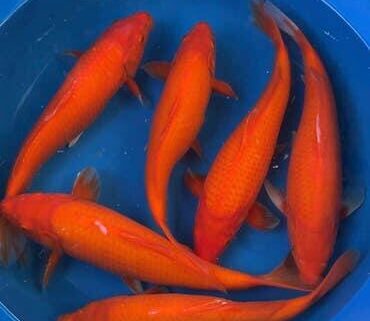
Cá Koi Hikarimoyo Cá Koi Hikarimoyo, hay còn gọi là Hikari, là một giống cá có lớp vảy kim loại và da ánh kim rực rỡ. Mỗi con cá thường sở hữu hai, ba hoặc nhiều màu sắc khác nhau. Trong tiếng Nhật, "Hikari" có nghĩa là kim loại hoặc ánh kim, trong khi "moyo" đề cập đến mẫu hoa văn, đó là cách để phân biệt các dòng cá dựa trên màu sắc. Hoa văn trên thân cá Hikarimoyo thường là hoàn toàn ngẫu nhiên, và một số mẫu hiếm hoặc độc đáo có thể được định giá rất cao. Dưới đây là một số dòng đã xuất hiện tại Việt Nam: - Hariwake: với hoa văn màu cam hoặc vàng. - Yamatonishiki: có hoa văn màu đỏ và đốm đen. - Kujaku: có nền vảy màu bạch kim với hình chữ nhật trên vảy, và hoa văn thường có màu cam hoặc đỏ. - Kikusui: thuộc dòng Doitsu (không có vảy) và có hoa văn màu đỏ. Cá Koi Hikari Utsuri Cá Koi Hikari Utsuri, như cái tên đã gợi lên, là một phân loại nhỏ của giống Koi Utsuri, được đặc trưng bởi lớp vảy sáng bóng. Sự phân biệt giữa các dòng Hikari Utsuri dựa trên màu sắc và dòng Utsuri của chúng. Hikari Shiro Utsuri, với màu trắng đen, là loại phổ biến nhất. Tiếp theo là Hi Utsuri, có màu đỏ, và cuối cùng là Ki Utsuri, với màu vàng, là loại hiếm nhất. Koi Hikari Utsuri không phải là loại cá nhanh nhẹn, chúng có thân hình mập mạp và di chuyển một cách nhẹ nhàng. Vẻ đẹp lạnh lùng của chúng khiến cho giống cá này còn được biết đến với biệt danh "Hoàng tử bóng đêm". Chúng tỏ ra rất kiêu hãnh và uy nghi. Khi bơi dưới đàn cá khác, chúng tạo ra một cảm giác như đang diễn ra một cuộc duyệt binh.

Cá Koi Hikarimuji mono Koi Hikarimuji mono và Koi Hikarimoyo gần như giống nhau về điểm chung là chúng đều có ánh kim loại (hikari). Tuy nhiên, điểm khác biệt quan trọng giữa hai loại này là Koi Hikarimoyo có nhiều màu sắc khác nhau trên thân mình, trong khi Koi Hikarimuji mono chỉ có một màu duy nhất cho toàn bộ thân hình. Các dòng phổ biến của Koi Hikarimuji mono thường là các dòng cá ogon. Chúng bao gồm các màu trắng (platinum ogon), đen (nezu ogon), vàng (yamabuki ogon), đỏ (hi ogon), cam (orenji ogon) và xám bạc (mukashi ogon). Cá Koi Goromo Giống cá koi này nổi bật với các hoa văn trên thân cá, được phối trộn trên nền màu trắng tuyết hoặc trắng sữa. Những mảng màu đỏ trên thân cá không phải là màu đỏ tươi như giống Kohaku, mà thường là màu đỏ thẫm, đậm. Đường viền xung quanh các mảng màu Hi có thể là màu xanh Indigo hoặc đen. Tiêu chí để đánh giá sự đẹp của Koi Goromo là màu sắc của nền da phải là trắng và sáng, không được nhạt hoặc pha vàng. Chúng sẽ có giá trị cao hơn nếu phần màu đỏ ít hoặc sạch sẽ, không có vết bẩn. Cá Koi Bướm Cá Koi Bướm, hay còn được biết đến với tên khoa học là Assorted Butterfly Koi, là một dòng cá koi đặc biệt, khác biệt hoàn toàn so với các giống cá đã được đề cập trước đó. Koi Bướm, theo cách gọi của người Việt, nổi bật với màu sắc sặc sỡ, cùng với những dải vây dài thướt tha tuyệt đẹp. Một số chú cá Koi Bướm có vây đuôi kéo dài gần bằng 2/3 chiều dài của thân. Màu sắc phổ biến của Koi Bướm bao gồm trắng, cam và vàng. Tuổi thọ trung bình của chúng dao động từ 25 đến 40 năm. Để chọn một chú cá Koi Bướm đẹp, quan trọng là phải chú ý đến dạng bơi của chúng, một cách uyển chuyển và thẳng thắn, cùng với phần đuôi cong tròn. Lớp da của cá phải sáng, sạch và mịn màng khi chạm vào.
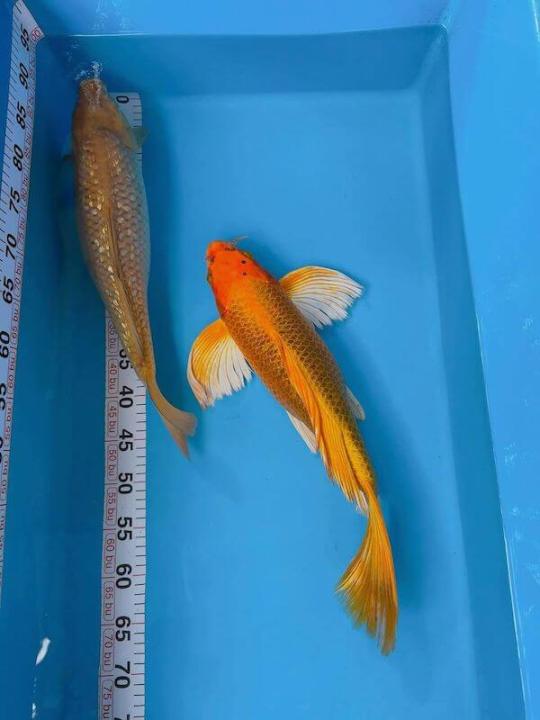
Cá Koi Kawarimno Cá Koi Kawarimono là nhóm phân loại cuối cùng để tổng hợp các loại cá koi mà không thuộc các giống đã được đề cập trước đó. Phân loại này thuận tiện nhất được chia thành ba nhóm: - Koi đơn sắc: Single Colored - Giống cá Koi màu đen đa dạng: Black Koi Breeds. - Các giống còn lại
Lưu ý để chọn cá koi đẹp
Khi quyết định mua cá cảnh, bao gồm cả các loại cá koi, bạn nên tìm hiểu từ nhiều nguồn tin đáng tin cậy hoặc những người chơi có kinh nghiệm để lựa chọn được giống cá chất lượng nhất. Để chọn được cá koi đẹp, bạn có thể tham khảo một số tiêu chí và lưu ý sau đây. Read the full article
0 notes
Text
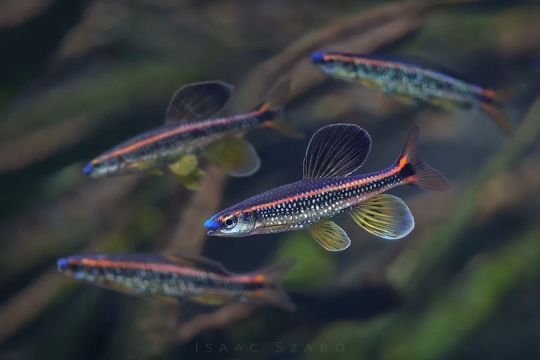
Bluenose Shiners (Pteronotropis welaka), males, family Cyprinidae, Cypriniformes, in a freshwater spring in Florida, USA
photograph by Isaac Szabo
#shiner#fish#cyprinidae#cypriniformes#pteronotropis#ichthyology#animals#nature#north america#bony fish
1K notes
·
View notes
Text
Taxonomy Tournament: Fish


Cypriniformes. This order is made up of carps (including koi) and their relatives, such as minnows and loaches.
Siluriformes. This order is made up of catfish, which have prominent barbels (sensory organs near the mouth) that resemble a cats whiskers.
#animals#biology#polls#poll tournament#zoology#carps#fish#catfish#Cypriniformes#Siluriformes#0x1bv0x64
120 notes
·
View notes
Text
Uncharismatic Fact of the Day
Even hippos need an occasional spa day-- that’s what barbel fish are for! A member of the carp family, these fish feed parasites, food bits, dead skin, and even dung from a hippo’s mouth and skin. The fish gets a tasty snack, and the hippo gets a deep clean: a win for everyone!

(Image: A school of Niger barb ( Labeobarbus bynni ) give a hippo a thorough cleaning by Bill Bailey)
If you like what I do, consider leaving a tip or buying me a ko-fi!
120 notes
·
View notes
Text

Barbs By: Unknown photographer From: Le Grand Fichier du Monde Animal 1975
107 notes
·
View notes
Text
If I were a mythical creature, I'd be:
A werewolf. Painfully transform on each full moon night into a grey wolf (Canis lupus) with my human mind gone for the duration of my time in wolf form, although I'm still smarter than actual wolves and thus able to strategise. Able to use moonlight magic in my human form. Can smell very well in both of my forms and have great hunting instincts in my wolf form.
Or
A mermin. Human (Homo sapiens) body from the waist upwards, cavefish (Cypriniformes cyprinidae) tail from the waist downwards. Bare-chested before puberty starts then wearing a seashell bra from age 10 'til at age 18 getting breasts-removal surgery. Can use siren's song to manipulate people by first singing 'bout what they want then singing what I want them to do. Able to breathe underwater and handle any water pressure.
Other werewolves and merfolks would have a different wolf form and fish tail respectively. Maybe some would have the same as me, but our human parts would still be distinct.
#obviously there are lots of different types of#werewolves#and#mermaids#in#fiction#this is simply my version of a#werewolf#and a#mermaid#mermin#merman#mermen#mermins#i can't afford a#masectomy#in real life yet#but hopefully as a mermin i woulda managed to save up enough whatever-it-is-that-merfolks-value to trade in exchange for having my#breasts removed#tw breasts#alex's thoughts#alex#ali#siren#sirena#seirína#σειρήνα#genderfluid#gender nonbinary#transgender
1 note
·
View note
